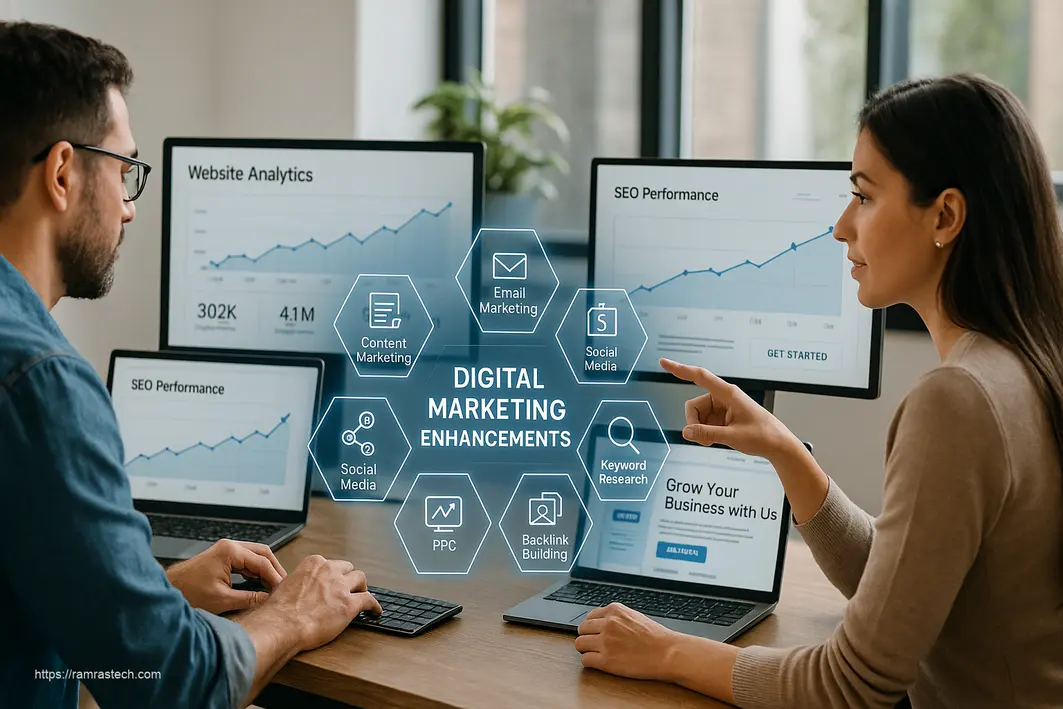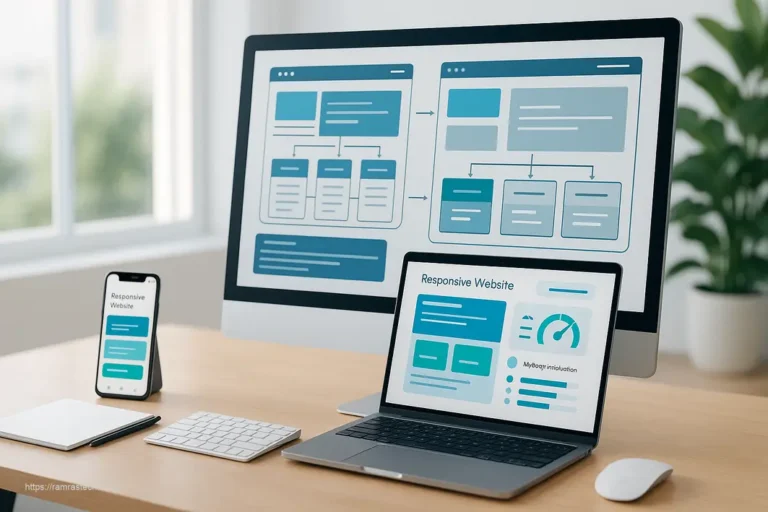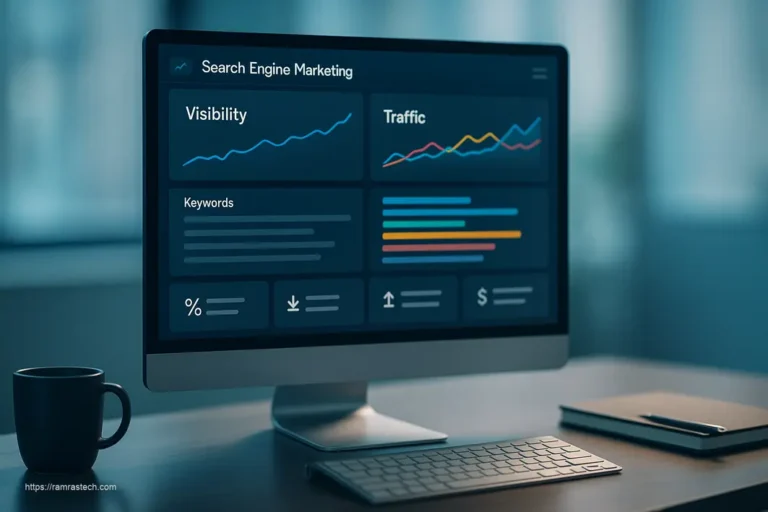7 Essential Digital Marketing Enhancements for Website Development

Ever wondered why some websites seem to dominate search results while others languish in obscurity? Or why certain online businesses convert visitors into customers effortlessly while others struggle despite beautiful designs? The secret often lies in digital marketing enhancements – strategic elements integrated during website development that can dramatically transform online performance.
In today’s hyper-competitive digital landscape, simply having a website isn’t enough. Businesses need integrated, strategic digital marketing enhancements to stand out, connect with their audience, and drive measurable results. Let’s explore why these enhancements matter and how they can revolutionize your online presence.
Why Digital Marketing Enhancements Are Essential for Modern Websites
Digital marketing enhancements are strategically integrated features, tools, and optimizations added during website development to maximize online visibility, user engagement, and conversions. Integrating these enhancements from the outset is essential, as they directly affect how effectively a website attracts, retains, and converts visitors, leading to sustained business growth.
Think of your website as a retail store. You wouldn’t open a shop in a location with no foot traffic, poor signage, confusing layout, and no way to track customer behavior. Yet many businesses launch websites without the equivalent digital features that drive traffic and conversions.
The data speaks for itself: websites with integrated marketing enhancements typically see 55% higher conversion rates and 37% lower bounce rates than those adding these features as afterthoughts.
The Crucial Connection Between Web Development and Digital Marketing
For too long, web development and digital marketing have existed in separate silos within many organizations. Developers build websites focusing on functionality and aesthetics, while marketers struggle to optimize what’s already built. This disconnection creates significant problems.
Digital marketing enhancements bridge this gap by ensuring marketing considerations are baked into development from day one. This integration creates a seamless foundation where technical structure supports marketing goals, and marketing initiatives can fully leverage technical capabilities.
When web development and digital marketing work together:
- Technical SEO becomes easier to implement
- User experience naturally supports conversion goals
- Analytics provide more actionable insights
- Marketing campaigns deliver stronger ROI
As one digital agency founder puts it: “The most successful websites we build are those where developers and marketers collaborate from the initial planning stages. This ensures marketing functionality isn’t an afterthought but part of the site’s DNA.”
How Integrated Development Amplifies Marketing Impact
When marketing considerations guide development decisions, the entire website ecosystem becomes more effective. For example:
- Page layouts designed with conversion paths in mind naturally guide users toward goals
- Content management systems configured for easy updating enable timely, relevant content
- Technical architecture built for speed and mobile responsiveness improves both user experience and search rankings
- Database structures that facilitate personalization enable more effective targeting
This thoughtful integration creates a multiplier effect where each element enhances the others, creating a sum greater than its parts.
7 Essential Digital Marketing Enhancements That Transform Website Performance
1. Advanced SEO Foundations: Beyond the Basics
While basic SEO practices like keyword optimization are common knowledge, truly effective digital marketing enhancements include more sophisticated SEO foundations:
- Technical SEO infrastructure: Implementing proper URL structures, site architecture, and schema markup that helps search engines understand your content
- Content optimization frameworks: Templates and guidelines that ensure all new content follows SEO best practices
- Internal linking systems: Automated and manual processes for building a strategic internal link structure
- Mobile optimization: Ensuring flawless performance across all devices through responsive design
One e-commerce site implementing these advanced SEO foundations saw organic traffic increase by 143% within six months of relaunch.
“The key difference between basic SEO and truly effective optimization is building the infrastructure for ongoing SEO success, rather than just optimizing what exists today,” explains a senior SEO specialist at a leading digital marketing agency.
2. Comprehensive Analytics Ecosystem Implementation
Basic analytics tell you what happened on your site. A comprehensive analytics ecosystem helps you understand why it happened and what to do about it.
Effective digital marketing enhancement includes implementing:
- Multi-platform tracking: Integration of Google Analytics 4, heat mapping tools, and conversion tracking
- Custom dashboards and reporting: Tailored to specific business goals and KPIs
- Enhanced e-commerce tracking: Detailed product performance metrics (for e-commerce sites)
- User journey mapping: Understanding the complete path from first touch to conversion
- Cross-device tracking: Following users across multiple devices and sessions
When properly implemented during development, these systems provide invaluable insights that guide future optimization efforts. One B2B company reported a 67% improvement in lead quality after implementing enhanced analytics that revealed which content truly engaged qualified prospects.
Check out our introduction to Google Analytics to start building your analytics foundation.
3. Strategic Conversion Rate Optimization Framework
Conversion optimization shouldn’t be a series of random tests but a strategic framework built into your site’s foundation.
Effective CRO enhancement includes:
- Modular design elements: Components designed for easy A/B testing
- Heat mapping and session recording setup: Tools that reveal how users actually interact with your site
- Micro-conversion tracking: Monitoring smaller steps along the customer journey
- Personalization capabilities: Systems that deliver customized experiences based on user behavior
“The most successful sites we work with have CRO built into their DNA,” notes a conversion specialist. “They don’t just test random elements – they have a framework for continuous, data-driven improvement.”
A financial services company implementing this strategic approach to CRO saw a 103% increase in qualified lead submissions within just three months.
Learn more about optimizing your conversion rate with our detailed guide.
4. Integrated Marketing Automation and Lead Generation Systems
Marketing automation shouldn’t be bolted on after launch but seamlessly integrated during development.
Key automation enhancements include:
- Form strategy and implementation: Creating effective lead capture mechanisms throughout the site
- Email marketing integration: Seamless connection with email platforms for immediate follow-up
- Progressive profiling: Systems that gather additional information over time without overwhelming users
- Lead scoring models: Automated ranking of prospects based on behavior and characteristics
- Workflow triggers: Events that automatically initiate marketing sequences
“When automation is properly integrated during development, it creates a smooth experience for both users and marketers,” explains a marketing automation specialist. “Users receive relevant content at the right time, while marketers get better data and more qualified leads.”
Discover unbeatable marketing automation strategies to implement for your business.
5. User-Centric Design With Marketing Intent
User experience design isn’t just about aesthetics – it’s about creating pathways that guide users toward business objectives.
This digital marketing enhancement includes:
- Strategic user journey mapping: Designing pathways based on marketing goals and user needs
- Intent-based navigation: Organizing site structure around user intent rather than company structure
- Conversion-focused design patterns: Implementing proven UX patterns that drive action
- Persuasive content placement: Strategically positioning content to maximize impact
“The best websites don’t feel like marketing tools, yet they subtly guide users exactly where the business wants them to go,” says a UX designer specializing in conversion-focused design. “That’s the magic of user-centric design with marketing intent.”
Explore smart website design tricks to enhance user experience.
6. Social Proof and Trust Signal Integration
Consumer trust is at a premium. Strategic integration of social proof and trust signals throughout the user journey can dramatically impact conversion rates.
Effective implementation includes:
- Dynamic testimonial systems: Displaying relevant testimonials based on the current page or product
- Review integration: Pulling in third-party reviews from platforms like Google or Trustpilot
- Case study frameworks: Templates and displays for compelling client success stories
- Trust badge placement: Strategic positioning of security and credibility indicators
- Social media evidence: Showcasing social engagement and following
One study found that optimally placed social proof elements increased conversion rates by up to 34% on key landing pages.
“Trust signals work best when they’re naturally integrated into the conversion journey, appearing at moments of decision or hesitation,” explains a conversion psychologist.
Learn how social media marketing can boost your brand’s credibility.
7. Content Marketing Infrastructure
Content marketing success depends on having the right infrastructure in place from the start.
This enhancement includes:
- Content hub architecture: Creating organized centers of topical authority
- Taxonomy and categorization systems: Ensuring content is properly organized and discoverable
- Content performance metrics: Built-in analytics for content effectiveness
- Related content algorithms: Systems that suggest relevant content to keep users engaged
- Lead magnet frameworks: Structures for creating and delivering valuable content in exchange for contact information
“Companies that invest in content infrastructure see 3-5 times better results from the same content than those who publish without a strategic framework,” notes a content strategy director.
Discover why businesses require content marketing and how to implement it effectively.
How to Implement These Digital Marketing Enhancements
Implementing these enhancements requires collaboration between development and marketing teams from the earliest planning stages. Here’s a practical approach:
- Conduct a digital marketing requirements workshop before development begins
- Create a detailed enhancement specification for developers
- Build a shared understanding of how marketing and development objectives align
- Establish integration points between marketing tools and the website
- Implement testing protocols to ensure enhancements function as intended
“The key is starting with marketing requirements rather than trying to retrofit marketing capabilities into an existing site,” advises a digital transformation consultant. “This approach saves time, money, and frustration while delivering superior results.”
Measuring the Impact of Your Digital Marketing Enhancements
To understand the ROI of your enhancements, establish baseline metrics before implementation and track improvements in:
- Organic traffic growth
- Search engine visibility
- Conversion rates at each stage
- User engagement metrics
- Lead quality and quantity
- Customer acquisition cost
One manufacturing company tracked a 43% reduction in customer acquisition cost and 78% increase in qualified leads after implementing comprehensive digital marketing enhancements during a website rebuild.
“The beauty of these enhancements is that they create compounding returns over time,” explains a digital marketing director. “Unlike one-off campaigns, they continue delivering value month after month.”
Stay Ahead With Evolving Digital Marketing Enhancements
The field of digital marketing enhancements continues to evolve rapidly. Staying competitive means keeping pace with emerging capabilities:
- AI-powered personalization: Creating individualized experiences at scale
- Voice search optimization: Preparing for the growing importance of voice queries
- Enhanced privacy compliance: Adapting to a cookieless future
- Automated content optimization: Using AI to refine messaging based on performance
“The organizations seeing the greatest success are those that view digital marketing enhancements not as a one-time implementation but as an ongoing program of continuous improvement,” notes a digital strategy consultant.
Frequently Asked Questions About Digital Marketing Enhancements
What is the difference between digital marketing features and enhancements?
Digital marketing features are standalone tools or functionalities that support marketing activities, while digital marketing enhancements represent strategic integrations that optimize the entire digital ecosystem. Enhancements are comprehensive implementations that align development and marketing goals rather than isolated features added to an existing framework.
How much should we budget for digital marketing enhancements during website development?
Typically, allocating 25-35% of your overall website development budget toward marketing enhancements provides the best return on investment. While this may seem substantial, companies that make this investment typically see faster ROI from their new website and avoid costly retrofitting later.
Which digital marketing enhancement should we implement first if we have limited resources?
If resources are constrained, focus first on comprehensive analytics implementation. This enhancement provides the insights needed to guide future optimization efforts and helps quantify the impact of other enhancements you may add later. Next, prioritize technical SEO foundations and conversion optimization frameworks.
How do we convince stakeholders to invest in these enhancements during development?
The most compelling argument is the cost comparison between implementing enhancements during development versus retrofitting them later. Retrofitting typically costs 2-3 times more and delivers results much more slowly. Share case studies of similar companies that have seen significant ROI from early enhancement implementation.
Can digital marketing enhancements be added to an existing website?
Yes, but the process is typically more complex and costly than implementing them during initial development. Many enhancements require changes to core site architecture or functionality. If working with an existing site, prioritize enhancements that can deliver the highest impact with the least structural change, then plan for more comprehensive implementation during your next redesign.
Conclusion: The Competitive Advantage of Digital Marketing Enhancements
In today’s digital landscape, the line between development and marketing continues to blur. The most successful organizations recognize that digital marketing enhancements aren’t optional add-ons but essential components of effective website development.
By integrating these seven crucial enhancements – advanced SEO foundations, comprehensive analytics, conversion optimization frameworks, marketing automation integration, user-centric design with marketing intent, social proof integration, and content marketing infrastructure – you create a website that doesn’t just exist online but actively drives business growth.
The question isn’t whether you can afford to implement these enhancements, but whether you can afford not to in an increasingly competitive digital environment.
Start by assessing your current website against these seven enhancement areas. Identify gaps in your digital marketing infrastructure and prioritize improvements based on potential business impact. Whether you’re planning a new website or optimizing an existing one, focusing on these strategic enhancements will deliver significant, measurable results for your business.
Discover more proven digital marketing strategies to dominate in 2025.






